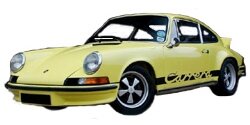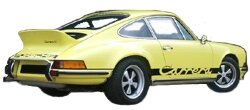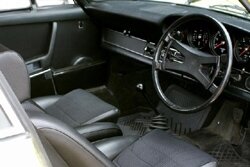Model Page
Porsche 911 Carrera 2.7 RS

|
Production Run: |
1,590 |
|---|---|
|
Production Date: |
1972 - 1973 |
|
Engine: |
Porsche 2,687cc 6 Cylinder |
|
Built: |
Zuffenhausen (Germany) |
|
0-60: |
5.5 secs |
|
Max Speed: |
153 mph |

The Porsche 911 Carrera 2.7 RS is in some quarters perceived as the greatest 911 ever produced, the car was developed by Porsche engineers with the intention of dominating the FIA Group 4 class of international racing. The RS was a lightweight development of the 911S with a larger displacement engine, RS stands for Rennsport in German and has a literal translation of race sport in English.

Porsche 911 Carrera 2.7 RS
Porsche wanted to compete in the European GT championship for which the 911 was eligible. Unfortunately the car would be racing against the Ferrari 365GTB Daytona Competizione, this car had an engine that was nearly twice the size of the largest 911 engine in production at the time, and clearly Porsche would be at a huge disadvantage. To combat this disadvantage Porsche started development of a new evolution of the 911S which would be lighter and boast a larger capacity engine.
The engine was a development of the 2.4 litre 6 cylinder lump taken from the 911S, the engine was overbored by 6mm and the cylinder walls coated in Nikasil, to increase the displacement to 2,687cc, this increased engine power to 210bhp @ 6,300 rpm up by around 30 bhp over the standard 2.4 911S, torque increased to 188lb/ft @ 5,100rpm. The engine utilised the same Bosch Mechanical Fuel injection system and five speed gearbox (fourth and fifth gears made slightly longer), the compression ratio of the engine remained standard at 8.5:1.

Porsche 911 Carrera 2.7 RS Rear Shot
Weight saving was taken very seriously in the design, with the interior and body being subject to drastic weight saving measures. The carpets were removed from the passenger cabin being replaced with lightweight black felt and the majority of the soundproofing material was removed. The interior clock was removed and the door panels had a small leather strap to operate the latches and a small plastic handle to pull the doors closed. To reduce weight further several components were completely removed fro the interior these being the rear seats, radio, glove box door and passenger sun visor. The front seats were replaced with lightweight Recaro bucket seats. Electric windows, and underseal were also removed from the car, adding to considerable weight savings.
Lightweight body panels were used providing a considerable reduction in weight with thinner sheet steel being used to manufacture the front and rear wings, the bonnet and the roof section. Furthermore the model used thinner glass and fibre glass bumpers and engine covers to reduce weight. To take the weight saving measures to the extreme the Porsche badge on the bonnet was replaced with a vinyl decal. These changes helped to bring the kerb weight down to only 960kg, this gave the car a 222bhp per tonne power to weight ratio.
The car featured a rear spoiler that was moulded into the engine cover, sometimes referred to as the Ducktail spoiler, large Carrera decals were fitted to the sills between the wheels as standard but these could be requested not to be fitted.
Modifications continued on throughout the car, Bilstein shocks were added as standard and the car benefited from the addition of modified sway bars to improve handling over the standard 911S.
To allow for the installation of larger wheels for racing the car featured flared arches, these accommodated the wider 15” aluminium Fuchs alloy wheels (6” wide front / 7” wide rear). The tyres fitted to the car were 185/70 VR15 on the front and 215/70 VR15 at the rear.

Porsche 911 2.7 RS Interior
The car was available in three forms, RS Touring form it weighed around 1075kg, sport lightweight form it was around 975kg, race trim weight was around 960kg. The touring car received steel bumpers and engine covers and had more interior luxuries with most of the interior being a direct take from the 911S. (The race trim and lightweight versions utilised the weight saving techniques listed above).
Porsche had originally anticipated a production run of only 500, however demand was so strong a further two 500 batches were manufactured taking the total production up to 1590 cars.
Today the Porsche 911 Carrera 2.7 RS is revered within the Porsche community and values have risen exponentially with the car costing more now than it did when first released.
The Facts
|
Engine: |
Porsche 6 Cylinder |
|---|---|
|
Capacity: |
2,687cc |
|
Valves: |
12 |
|
Compression Ratio: |
8.5:1 |
|
Fuel System: |
Bosch K-Jetronic Injection |
|
Maximum Power: |
210bhp @ 6,300 rpm. |
|
Maximum Torque: |
188lb/ft @ 5,100 rpm. |
|
Transmission: |
Manual 5 speed. |
|
Top Gear: |
- |
|
Brakes: |
Servo Assisted Ventilated Front Discs / Ventillated Rear Discs |
|
Kerb Weight: |
960 Kg |
|
Max Speed: |
153 mph |
|
0-60: |
5.5 secs |





